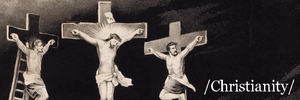For the heretics call upon the scriptures by vainly twisting its words and creating their own meanings, and they even cite the prophet Moses who said,
"Thou shalt not make thee any graven image, or any likeness of any thing that is in heaven above, or that is in the earth beneath, or that is in the waters beneath the earth:"
(Deut 5:8)
But what did that holy prophet Daniel write?
"I beheld till the thrones were cast down, and the Ancient of days did sit, whose garment was white as snow, and the hair of his head like the pure wool: his throne was like the fiery flame, and his wheels as burning fire. A fiery stream issued and came forth from before him: thousand thousands ministered unto him, and ten thousand times ten thousand stood before him: the judgment was set, and the books were opened." (Dan 7:9-10)
And who would admit that the Ancient of days is another than the Father himself? For both the Ancient of days and the Son of Man are spoken about here, God the Father and God the Son. Thus an icon of God is conjured up in our minds, and it was surely the intention of the prophet to do so, for why would he have described the Deity if he had not intended for an icon of him to become present in our minds? Even in the Old Testament there is a depiction.
(It must be noted that Icons may be generated in our minds by other means,
"He shall cover thee with his feathers, and under his wings shalt thou trust: his truth shall be thy shield and buckler." (Pslm 91:4)
Indeed, the Psalms, and the Old Testament in its entirety, often speaks about God anthropomorphically. Yet it must be admitted here that the intentions of the psalmist and of the other authors are metaphorical rather than mystical in nature, like that of Daniel, and must only be considered a drop in the bucket of this defense, and this is known by their lack of true description. Now the Icons these generate in our mind are unintentional are have been spoken of so we might better identify with God as men or to stir up our love for God.)
Now what of the Son?
"And in the midst of the seven candlesticks one like unto the Son of man, clothed with a garment down to the foot, and girt about the paps with a golden girdle. His head and his hairs were white like wool, as white as snow; and his eyes were as a flame of fire; And his feet like unto fine brass, as if they burned in a furnace; and his voice as the sound of many waters. And he had in his right hand seven stars: and out of his mouth went a sharp twoedged sword: and his countenance was as the sun shineth in his strength." (Rev 1:13-16)
John visions are a return to Daniels, and we know what he means by these things, for in his gospel he says,
"No man hath seen God at any time; the only begotten Son, which is in the bosom of the Father, he hath declared him." (Jhn 1:18) And, "Philip saith unto him, 'Lord, shew us the Father, and it sufficeth us.' Jesus saith unto him, 'Have I been so long time with you, and yet hast thou not known me, Philip? he that hath seen me hath seen the Father; and how sayest thou then, Shew us the Father?'" (Jhn 14:8-9)
John testifies to us the true Gospel, the catholic Gospel that the man, that holy apostle, Paul himself, preached when he wrote, "Who is the image of the invisible God, the firstborn of every creature:" (Col 1:14)
Christ Jesus is the image of the Father, a perfect representation of him. Those heretics who break the icons and overthrow the images are deniers of the incarnation, having followed even the Iota but forgetting the spiritual nature of God, "for the letter killeth, but the spirit giveth life" (2 Cor 3:6)
We know that "God is a spirit" (Jhn 4:24), who is neither "like unto gold, or silver, or stone graven by art and man's device" (Act 17:29), and we mightily detest those heretics who say we worship the material of the icons. Rather we worship the figure represented by these. For we know that God gave representations of heavenly beings to Moses when he instructed him on building the ark of the holy covenant (Exod 25:18) So God himself came down, taking on the appearance of a man (Phil 2:8), and suffering on our behalf, revealing himself and his Father to the whole world through an image most especially in the suffering, death, and resurrection.
(Continuing…)
